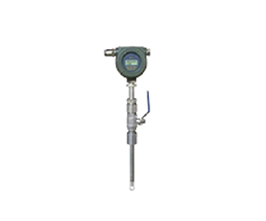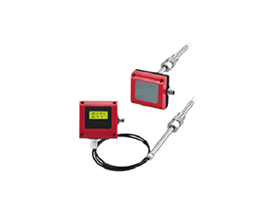
IMMERSION TYPE THERMAL MASS FLOWMETER
Thermal mass flow meters are products developed to measure the mass of gaseous fluids. Standard flowmeters need pressure and temperature compensation in order to measure flow properly. However, mass flow meters can directly calculate the mass flow value of the fluid without the need for compensation. Mass flowmeters are preferred due to their ease of direct application, the absence of any moving parts, very low-pressure loss, wide measuring range, high sensitivity, and high reliability. Thermal mass flow meters are mainly used in petroleum derivatives, chemical industry, medical industry, heat plants and environmental protection sectors. Immersion Thermal Mass (Mass) flowmeters are a preferred model in areas where serial flowmeters cannot be used, or in environments with high pipe diameters.
The working logic is the same as the fixed type. In processes with a flow rate as low as 0.2 m/sec, the immersion type should be preferred when the interaction between the heater probe and the measuring probe will increase.
Immersion Thermal Mass (Mass) flowmeters can be used between DN20 - DN100. If detailed information about the line diameter, temperature and product information to be used by the user is given, the product can be calibrated more precisely.
Thermal mass flow meters operate on the principle of temperature diffusion. The heat dissipation technique provides excellent performance and high reliability under many harsh conditions. Flow detection is provided by 2 platinum RTD temperature resistors. One of these two sensors is the speed sensor and the other is the temperature sensor with automatic changing temperature compensation. These 2 RTD sensors are located in the middle of the flow tube. The speed sensing sensor is heated by a continuous difference at a temperature above the ambient temperature, and the temperature sensor responds to the ambient temperature. As the gas velocity increases, the amount of heat transferred from the sensor to the environment also increases. For this reason, the power drawn by the sensor also increases. Thus, the heater RTD sensor gives the mass flow information based on the power electronics principle.
General Applications:
➢ Gas flow passing through the industrial pipe,
➢ Measurement of air formed during gas combustion,
➢ Flue gas measurements,
➢ Gas measurements formed during water treatment,
➢ Measurements of trapped gas in cement cigarette and glass production,
➢ Measurements of natural gas, coal gas, liquefied gas, flammable gas and hydrogen gas,
➢ Compressed gas used in the steel industry, etc.



